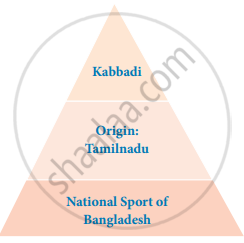Advertisements
Advertisements
प्रश्न
What impression of the character of Iona do you get from this story?
उत्तर
Iona was an old cab driver; he lost his young son. Being lonely, he was reduced to a phantom figure. He desperately wished to talk and share his sentiments with someone. He was so shattered that he tried to talk to any or everybody. He lamented his loss, despair and melancholy encompassed him. He was plunged in the thoughts of his son so much that he was totally unaware of his surroundings, even the snow. He drove his sledge rashly and brandished his horse more than necessary. He lost control over his emotions and went one blabbing his loss in front of even the ones who would be least interested to know. He tried talking to his passengers, the policemen, and the three drunkards. He was afraid of his withered age and that his son was gone. He knew it would be difficult for him to earn his livelihood. He even made a remark to the horse that had his young son been alive, they would not have suffered and would have had plenty of food to live on. His state was of a typical old man who loses his young son and feels helpless and only grieves.
APPEARS IN
संबंधित प्रश्न
What role did Mr. Gilman play in Helen Keller's life? (120‒150 words)
What was Mr. Otto Frank's major contribution to the world?
Anne describes herself as a 'little bundle of contradictions'. Why? Explain in your own words.
Notice the following uses of the word ‘tell’ in the text.
1. Her fingers were busy telling the beads of her rosary.
2. I would tell her English words and little things about Western science and learning.
3. At her age, one could never tell.
4. She told us that her end was near.
Given below are four different senses of the word ‘tell’. Match the meanings to the uses listed above.
1. make something known to someone in spoken or written words
2. count while reciting
3. be sure
4. give information to somebody
What do you understand of the natures of Ramanand and Azam Khan from the episode described?
What do you think is the message that the author seems to convey through the story?
What were the attempts made by the author to get his watch repaired?
'New Literature' is a misnomer for the wealth of the Indian Literary tradition. How does G. N. Devy explain this?
How is colour highlighted in the poem and why? List all the words in the poem that suggest colour.
Answer in your own words.
What explanation did he give to the fellow- pilgrim for his thoughtful deed?
Discuss the activities carried out by a farmer.

Behrman did not know anything about the last leaf on the ivy.
Form groups and hold debates on the following topics. Make bulleted lists of points in favour of the topic (pros) and those against it (cons). (3-6 points each)
You should admit your mistakes.
Read the following sentence aloud. Write who said it and to whom.
“Would you lend me this, just this?”
There were no old cities left on the earth.
Pick out the line that means:
Sing in such a manner:
Find out how the following game is played.
Badminton
How was Gulliver taken to the city?
Answer the following question in about 100-150 word.
Narrate the extensive search operation made by the policemen in the house.
Pick out the other examples for alliteration from the poem.
Neerja leapt into action when she______.
Identify the sports and the sports personalities from the lesson and fill in the table.
| Sports | Name of the player & Field of sports | Awards |
 |
||
 |
||
 |
Jaswant was helped by __________ tribal girls.
The message was to gather on ______.
Number the actions of Pandi and Nandhini in order.

Does the poet want diversity? why?
Keep moving though your progress is ______.
Who are already awake?
From where did the naughty boy come?
The passage given below is on Kabbadi. Read the passage and complete the activities that follow.
Kabbadi (கபடி - in Tamil) is a contact team sport that originated in Tamil Nadu, India. It is the national sport of Bangladesh. It is also popular in South Asia and is the state game of the Indian states of Tamil Nadu, Kerala, Andhra Pradesh, Bihar, Haryana, Karnataka, Maharashtra, Punjab, and Telangana.

Kabbadi is played between two teams of seven players: the objective of the game is for a single player on offence referred to as a 'raider', to run in to the opposing teams half of a court, tag out as many of their defenders as possible, and return to their own half of the court–all without being tackled by the defenders. Points are scored for each player tagged by the raider, while the opposing team earns a point for stopping the raider. Players are taken out of the game if they are tagged or tackled, but can be 'revived' for each point scored by their team from a tag or tackle. The raider should hold his breath and utter the words like 'kabbadi kabbadi, hututu hututu, chadu kudu' etc. while the opponents try to catch him. If he stops uttering these words, he is considered out.
The game is known by its regional names in different parts of the subcontinent, such as Kabbadi or Chedugudu in Andhra Pradesh, Kabbadi in Kerala and Telangana, Hadudu in Bangladesh, Bhavatik in Maldives, Kauddi or Kabbadi in the Punjab Region, Hu-Tu-Tu in Western India and Hu-Do-Do in Eastern India and Chadakudu in South India. The highest governing body of Kabbadi is the International Kabbadi Federation.
Given below is the visual presentation of the first paragraph.

i) Represent the other paragraphs in a visual form of your choice(flow chart, mind-map, pie-chart, etc.).
ii) Choose the correct option.
1. A contact sport usually involves a ______contact between players.
- violent
- gentle
- physical
2. Kabbadi is a game played between ______.
- seven teams of two players
- two teams of seven players
- four teams of seven players
3. A single ______.
- player on offence is referred to as a raider
- offence is referred to as a raider
- raider is an offence by the player
iii) Answer the following.
- How does a raider score points for his team?
- When does a raider concede a point to the opponent team?
- Can a player be revived when he/she is out of the game? Explain your answer.
- Kabbadi is called by different names in different parts of India. Do you know how Pallankuzhi is called in Karnataka, Andhra Pradesh and Kerala?
